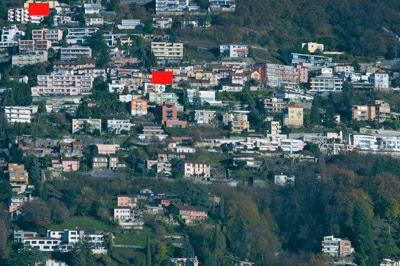Around 1985, when I was sixteen I used to take quite a few pictures of girls. My 135mm was a bit short for those snapshots - thus a 300mm tele would be ideal i thought. But before actually ordering my Mamyia Sekor E 4/300mm I discussed the issue with my latin teacher (a passionate girl photographer as well). His advice was to go for a good 4/200mm since "the 300mm lenses are not that crisp any more". I followed his advise, and the Sekor E 4/200mm made me more than happy. Only much later I bought my first 300mm (the Minolta AF 2.8/300mm APO), and even that lens was not as perfectly corrected as the AF 2.8/200mm APO I already owned. Yes, the 300mm lenses are harder to correct than the 200mm teles ...
Here a a few Minolta MC/MD classics compared on the 16 MP APS-C NEX-5N - obviously on a much more boring subject: the suburbs of Lugano in Switzerland.
The Minolta MC 4.5/300mm [6/6] is quite a beast (nearly 1.2 kg), and consequently it has a sturdy tripod socket. It was the third 4.5/300mm from Minolta - the previous constructions were much simpler [4/3] and [4/4] designs.
The [6/6] construction shown here was part of the series of fast new MC optics presented at Photokina 1968 (others were the MC 2.8/16mm Fisheye, 2.8/21mm, 2.5/28mm, 1.8/35mm, 1.2/58mm, 1.7/85mm and 2.5/100mm). All these lenses were using new optical glass from Minolta with low dispersion and/or high refraction. In fact the magazine "Popular Photography" claimed this MC 4.5/300mm was "the best 300mm ever tested at our labs".
The MC 4.5/300mm has a surprisingly high resolution on 16MP APS-C, even wide open and even in the corners. However, wide open at f4.5 the longitudinal CAs (LoCAs) are quite pronounced and disturbing. Stopping down to f8 of f11 makes sense. One can reduce the effects of LoCAs by slightly "misfocusing" the lens (see image below), but then the resolution is reduced.
The Minolta MC 4.5/300mm in its MC-X variant from 1973. The lens performs identically as the MC-II shown above. Therefore I have shown here the results of slightly "misfocused" lens: While the LoCAs are reduced, the overall "sharpness" / resolution suffers quite much. The MC 4.5/300mm certainly was avery good lens 40 years ago, but the use of only one LD glass element obviously was not sufficient to fully correct its color aberrations.
In 1978/79 Minolta introduced its second series of MD lenses. Most of them were substantially smaller and lighter than their precursors. The new MD 4.5/300mm IF was only 710g. It has internal focusing (IF). Two lenses are shifted separately using mechanisms usually found in zoom lenses. The new 4.5/300mm IF is remarakbly free of LoCAs at full aperture (left images). It can be used wide open even on 16MP APS cameras. At f8 the microcontrast increases, especially in the center, and lateral CAs become more pronounced.
The new 4.5/300mm IF certainly is a pleasure to use: Much lighter, much easier to focus, and with a much better close focus (3 m instead of 4.5 m). However, its IF focusing mechanism is prone to wearing, and some MD 4.5/300 mm IF are visibly and reversibly de-centered after years of professional use.
The MC 300mm 1:5.6 [5/5] was first introduced in 1973, replacing the elder non-MC [4/4] version from 1965. The lens basically has a similar overall perfomance as the MC 4.5/300 mm - with a little bit less LoCAs, and less APS-C corner resolution.
The MD 100-300mm 1:5.6 (1983) probably was not manufactured by Minolta. Performing not very well, it was replaced only three years later by the AF 4.5-5.6/75-300 mm. This lens shares characteristics typically found on third-party zooms: Extremely low contrast and low detail resolution at f5.6, acceptable performance only at f11.







